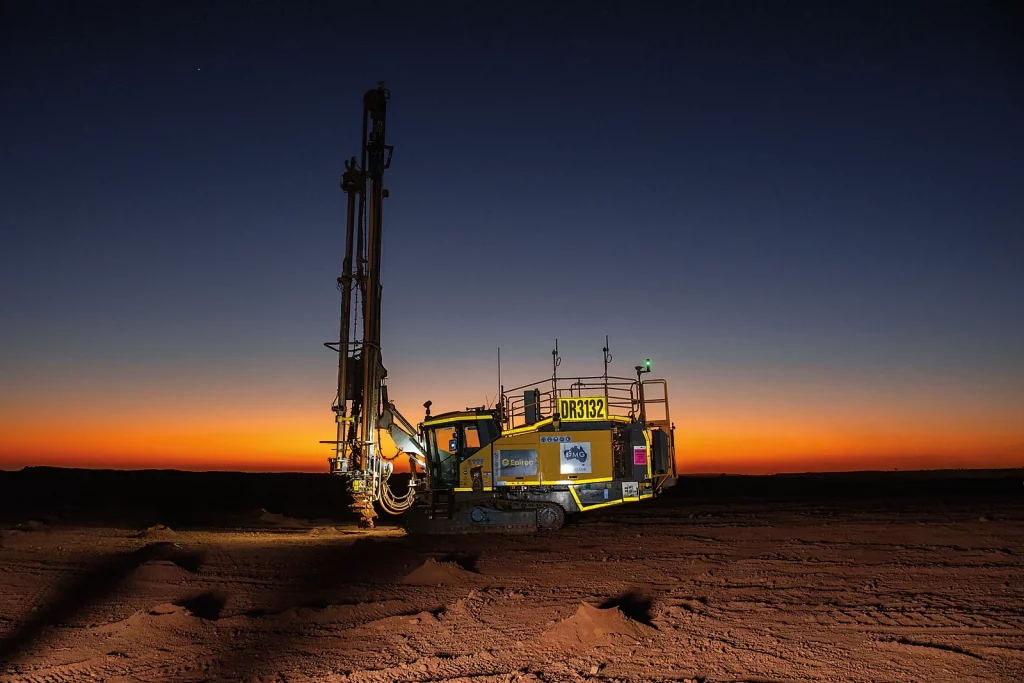In Australia’s Pilbara iron ore mining area, Epiroc and Fortescue have been working together to develop the SmartROC D65 Autonomous drill rig that Epiroc says is pushing the boundaries of autonomous mining. The rig was first deployed at Iron Bridge in the East Pilbara, the joint venture mining project between Fortescue Metals Group subsidiary FMG Magnetite and Formosa Steel IB, with the US$3.9 billion operation near Marble Bar producing high-grade magnetite.
Epiroc agreed to a partnership with Fortescue Ltd in 2021 to use the SmartROC D65 MKII Autonomous on a Fortescue mine site for a trial period of at least 12 months. Iron Bridge Mine was selected as the best-fit site for the trial’s objectives. The trial began in 2022, and the rig hit production KPIs in May 2023. As of 2024, all activities related to autonomous implementation and future development were moved to Solomon Hub in the central Pilbara north of Tom Price.
“It’s great to be working with Epiroc here at Iron Bridge and seeing the SmartROC D65 drill in action,” says Graham Howard, Director of Operations at Iron Bridge last year.
High temperatures – often 45 degrees Celsius – made this an ideal place to trial any equipment, autonomous or not. But Epiroc says Iron Bridge presented other opportunities to put this new test version of the SmartROC D65 Autonomous through its paces. The magnetite is buried in hard rock beneath metres of looser clay-like soil and then transitional earth, meaning the rig is drilling under various conditions. “We want that,” says Nick Howlett, an Epiroc Automation Specialist. “It’s how we develop and make a good product.”
Fortescue has a reputation for being a forward-thinking mining house. It has been pursuing autonomous solutions for well over a decade, making it a natural partner in the SmartROC D65 Autonomous program.
Epiroc and Fortescue entered a partnership in 2021 to trial this MKII version of Epiroc’s SmartROC D65 Autonomous. This project followed a 2018 SmartROC D65 Autonomous MKI pilot project in Canada. A successful test would provide Fortescue with an autonomous blast drill solution and Epiroc with vital test intel under realistic mining conditions.
“There’s no doubt autonomous is the way the industry’s going,” says Epiroc Australia General Manager and Managing Director Wayne Sterley. “And that speaks to the inherent productivity, efficiency and safety gains of autonomous solutions.”
An autonomous SmartROC D65 rig’s advantages aren’t down to pure speed but tend to accumulate over time via a clever use of autonomous subsystems and the high quality and consistency of the holes it produces. “A manual operator could maybe beat us over an hour or so, but that’s not what it’s about,” Howlett says. “It’s about consistency. When the operator goes for a break, we drill. If there’s blasting nearby, we drill. And our shift changes tend to be shorter. We’ve spent a lot of time perfecting how the rig drills autonomously, including water control, how it starts a hole, and the tricky aspects of collaring. We’ve also tuned it for different types of ground, with five different settings. You set these different parameters, the operator selects one and the drill gets to work.”
The SmartROC D65 Autonomous has also had an edge in pre-split drilling. At Iron Bridge, operators drilled up to 30 m at an angle, meaning it’s relatively easy for unintended deviations in holes. The autonomous rig was more precise in these scenarios, making for better drilling predictions and, in turn, easier drill plan adjustments. Consistency also has positive impacts on equipment life cycles, with the SmartROC D65 MKII Autonomous rig’s autonomous algorithms utilising components such as cylinders, feed chains, rotation heads, and rock drilling tools more optimally.
At its test sites, the rig looks similar to a manually operated drill but features LiDAR and cameras on the machine’s front, back and top. There are also automation mode (safe-to-board) lights for transitioning from remote to local operations. Surrounding traffic cones mark out the SmartROC D65 MKII Autonomous rig’s geofence, or perimeter of autonomous operations.
The drill was controlled from the Iron Bridge remote ops centre. The SmartROC D65 MKII Autonomous rig’s tele remote station sat in a separate low-lit control room. It features two joysticks, a touch screen like that inside the rig, and three additional LCD screens that display critical operational information – hole and drill pattern progress, a video stream from the rig’s onboard camera system, and the drill’s technical state and alarms.
“Like any new tech, there’s been some skepticism,” Howlett says. “But [Fortescue] has begun to advertise for jobs for autonomous operators and there’s been a lot of interest. One of the lads told me he sees it as an opportunity to see more of his family in Perth.”
“We have the opportunity to put people in a safer working environment, and help them be more productive and efficient,” Sterley adds. “By taking on this digital transformation, we’ll attract more talent into the industry.”
So, what’s next for the SmartROC D65 Autonomous program? After the 2022/2023 success at Iron Bridge, 2024 is about tackling autonomous contour mining at Fortescue’s nearby Solomon Hub. “There’s a lot of knowledge about path planning and obstacle detection but not about tramming for contour operations,” Howlett says. “Those are wicked challenges. We’re looking forward to giving it a crack.”











